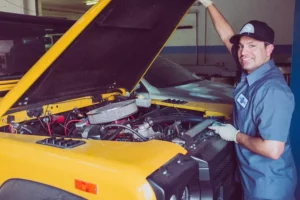
Catalytic converters are essential for the environment. They ensure that vehicular emissions are low and that our cities are free from smog.
These devices are located underneath the vehicle and form part of the exhaust. In most models, you can find the catalytic convertor between the exhaust manifold and the resonator.
The catalytic converters are lined with reactive metallic components.
These metallic components react with pollutive emissions, converting them into carbon dioxide and vapor. In so doing, the converters prevent toxins created as a result of combustion from being released into the environment.
In most countries, it is illegal to tamper with the catalytic converter. Doing so attracts a hefty fine. These converters have become targets for car part thieves.
Are you trying to figure out how to bypass the catalytic converter check engine light?
How to bypass catalytic converter check engine light
Step 1: Disconnecting the oxygen sensor and dismounting the convertor.
Step 2: You should add a bypass pipe to replace the converter.
Step 3: Reattach the oxygen sensor.
Step 4: The check engine light will turn off.
Why You Should Not Tamper with Your Catalytic Converter
Catalytic converters are essential and should be left intact. Tampering with the convertor can have severe consequences for your vehicle and the environment.
Here are reasons why you must never tamper with the catalytic converter
1. Pollution
Car manufacturers added converters to vehicles to stem pollution. By detaching the converter, your vehicle will release toxins into the environment. Not only is it morally reprehensible, but it violates many pollution regulations.
We must regulate emissions for the safety of the environment. In cities where regulations are lux, it is not uncommon to see the sky filled with smog from vehicles.
2. Exhaust noise
Bypassing the catalytic converter will make your exhaust significantly louder. The rumbling noise will reach deafening levels. The catalytic converter absorbs most of the noise and thus makes the exhaust quieter.
3. Erratic acceleration
Interfering with the catalytic converter will result in erratic acceleration. It occurs due to an unregulated exhaust.
The engine is prone to uneven power draws as it tries to push out combustion byproducts. These draws are irregular and dangerous if the converter is not in place.
4. Legality
In most countries, it is illegal to interfere with the catalytic converter. Doing so attracts hefty fines and penalties. United Nations Global Vehicle Emission Standards govern most countries.
The United Nations Environmental Program sets these standards.
In the United States, the fine for tampering with the catalytic converter is $2500 per violation. It is an effective deterrent for individuals and auto shops.
5. Inspection
Any vehicle without a catalytic converter is undoubtedly going to fail an inspection. Without a working catalytic converter, it is impossible to renew your registration. The NC emissions inspection is done annually on all vehicles to ascertain their roadworthiness.
Preventing Catalytic Converter Theft
Catalytic converter thefts have become rampant in recent times. Many car thieves target these parts and sell them for scraps or dubious auto shops.
Urban centers are mostly affected by these criminals. You must take steps to ensure that your converter is safe at all times.
Here’s how to keep your converter safe:
1. Secure parking
You can avoid nearly all theft related to catalytic converters by packing your vehicle in a secure location.
Many thieves look for easy targets. They focus on cars that have been parked in poorly light areas or those that are left unattended for long periods.
It would help if you parked your car in areas where CCTV cameras are available and working.
Parking your car in open public places with a lot of foot traffic could help deter thieves.
2. Use a car alarm
A car alarm is useful for keeping your car secure. Thieves hate having to deal with car alarms and would rather not bother with cars that have alarms. Do not disable your alarm, especially at night.
3. Invest in a protective cover
Some covers have been specially designed to secure catalytic converters. You can find these covers for most models in the market right now. It is nearly impossible for thieves to access your converter when you use these covers.
You can have a custom protective cover installed at your local body shop. Covers are also available from your car’s manufacturer.
Just remember that it is cheaper to invest in a protective cover than to replace the catalytic converter.
4. Tracking
Scrap metal dealers are wary of taking trackable parts, especially converters. You must ensure that you make your converter identifiable. To do this, add your vehicle’s serial number onto the converter.
Basic Catalytic Converter Maintenance
Like all parts of your vehicle, catalytic converters have to undergo maintenance every once in a while. The best way to ensure that your converter is functioning optimally is by ensuring that it is clean.
There are situations that necessitate replacing your converter, but before you do, try and clean it thoroughly.
There are two ways to clean your converter. You can either detach the unit from the vehicle and clean it separately or clean it while it is intact.
Basic cleaning
Basic cleaning involves using a special cleaning agent known as a catalytic converter cleaner. These cleaners work differently based on your fuel type and the type of agent.
To clean your converter, pour the catalytic cleaner into the fuel tank. Ensure that you have enough fuel in the tank, or you might cause the engine to knock.
The agent works when the engine is on and actively drives the car. The liquid passes through the honeycomb filters, breaking down chemical compounds.
It descales and cleanses the filters, effectively de-clogging them and allowing them to function optimally.
It would be best if you used catalytic converter cleaners frequently.
Advanced Cleaning
Advanced cleaning involves removing the catalytic converter from the exhaust. To do this, you will need a wrench and penetrating oil.
Use the oil to expose the screws and the wrench to detach the catalytic converter from the central unit.
Detach the oxygen sensor and place the converter away from the vehicle. On a basin, mix a degreaser and a catalytic converter cleaner. Let the solution sit for a while.
Using a high-pressure hose, wash the outside of the converter, the outlet, inside and outside. Place the converter into the mix and let it sit for a while. Use hot water to power wash the inside of the converter.
Air the converter and allow it to dry. Reattach the converter and reconnect the oxygen sensor. Advanced cleaning might be difficult, but it is an effective way of getting rid of all the grime and dirt.
Detecting A Faulty Catalytic Converter
A faulty catalytic converter will impact your engine’s performance. It is easy to know whether the converter is functioning optimally. But how can you tell whether the device is faulty?
1. Exhaust color
The color of the smoke coming from the exhaust can help you ascertain whether you need to replace the converter if the exhaust smoke is thick and dark, the catalytic converter malfunctions and needs to be adjusted.
2. Exhaust smell
A malfunctioning catalytic converter will leave your exhaust smelling like Sulphur dioxide. It is a smell not too dissimilar to that of rotting eggs. If this happens, it is prudent to replace the converter as soon as possible.
3. Overheating engine
The temperature warning light will turn on to indicate that the engine is overheating. A faulty exhaust causes overheating, as it strains the engine. The engine draws more power trying to expel the combustion byproducts.
4. Erratic acceleration
The engine performance is the most affected by a faulty catalytic converter. It causes reduced acceleration at higher power draws. It makes the vehicle inefficient, unpredictable, and dangerous to drive.
5. The engine turns off mid-drive
It is common for cars with faulty catalytic converters to stall multiple times as they’re being driven.
Types Of Catalytic Converters
Catalytic converters are classified based on their filtration characteristics. There are three main types of catalytic converters.
1. Oxidation catalyst
An oxidation catalyst cleanses the air from carbon monoxide and hydrocarbons. They attach oxygen molecules to the two compounds to form carbon dioxide and water.
2. Three-way catalyst
A three-way catalyst cleanses the air of hydrocarbons, carbon monoxide, and nitrogenous waste.
3. Three-way catalyst and oxidation catalyst
It has the filtration properties of the oxidation and three-way catalyst.
Conclusion
A catalytic converter is an essential addition to the exhaust system. It cleans up the emissions from vehicles. When fuel is oxidized through combustion, it releases toxins that would have ended up in the air if not for the converter.
It is possible to bypass the catalytic converter check engine light. In most countries, it would be illegal to do so. Many countries have emission regulations that bar people from removing their catalytic converters. These devices have become targets for car part thieves in many urban areas.


